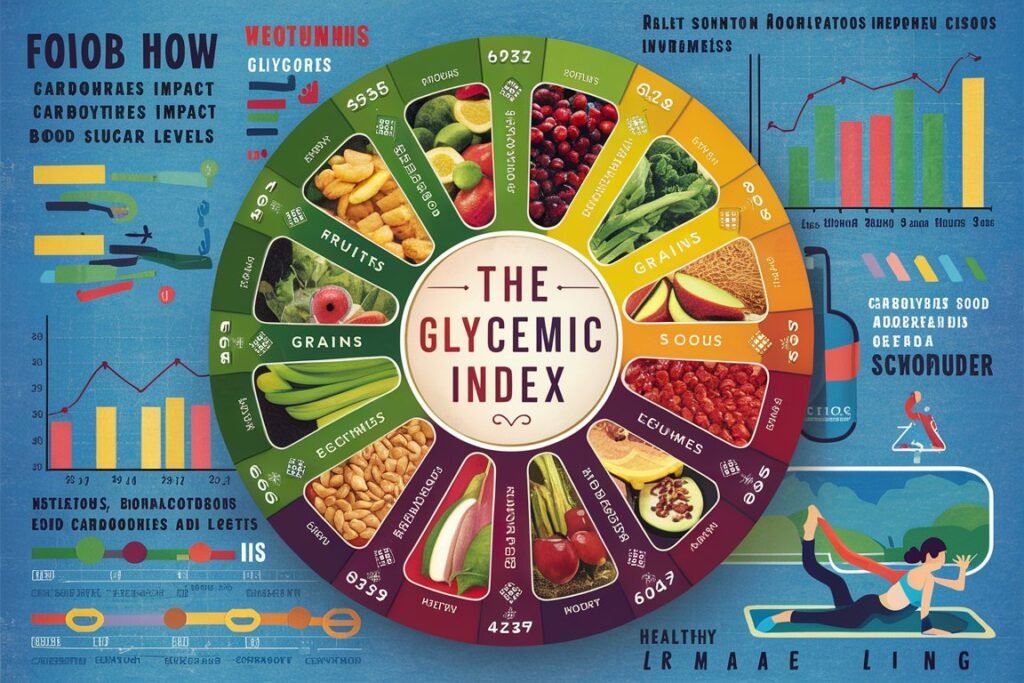The Glycemic Index: Understanding Carbohydrates and Blood Sugar Control
Hey there, my young and curious friends of 2024! It’s your favorite nutrition explorer, Nita Sharda, here to take you on an exciting journey into the world of carbohydrates and blood sugar. Now, I know what you might be thinking – “Carbohydrates and blood sugar? That sounds like something only doctors and scientists care about!” But trust me, understanding how the foods we eat affect our blood sugar levels is important for everyone, no matter what age we are.
Today, we’re going to put on our explorer hats and discover a tool called the Glycemic Index, which can help us make smart choices about the types of carbohydrates we eat. But before we dive in, let me make one thing clear – this is not about putting anyone on a strict diet or making them feel bad about what they eat. It’s simply about empowering you with the knowledge and tools to make food choices that support your health and well-being, now and in the future.
So, are you ready to join me on this blood sugar adventure? Let’s go!
What are Carbohydrates?
First things first, let’s talk about what carbohydrates actually are. Carbohydrates are one of the three main nutrients in food, along with protein and fat. They’re the body’s main source of energy, and they come in many different forms, from the sugar in candy and soda to the fiber in fruits and vegetables.
When you eat carbohydrates, your body breaks them down into a simple sugar called glucose, which is then absorbed into your bloodstream. Your blood carries the glucose to your cells, where it’s used for energy to power everything from your brain to your muscles.
The Importance of Blood Sugar Control
So, why is it important to pay attention to how carbohydrates affect your blood sugar levels? Well, when you eat carbohydrates, your blood sugar levels naturally rise as the glucose is absorbed into your bloodstream. In response, your body releases a hormone called insulin, which helps move the glucose out of your blood and into your cells.
If your blood sugar levels rise too high or too quickly, it can put a strain on your body’s ability to produce enough insulin to keep up. Over time, this can lead to a condition called insulin resistance, where your cells become less responsive to insulin’s signals. Insulin resistance can increase your risk of developing type 2 diabetes, heart disease, and other health problems.
On the other hand, if your blood sugar levels drop too low, you may feel tired, shaky, or dizzy. This can happen if you go too long without eating or if you eat foods that cause your blood sugar to rise and fall quickly.
The goal is to keep your blood sugar levels in a healthy range – not too high, not too low. And that’s where the Glycemic Index comes in!

What is the Glycemic Index?
The Glycemic Index (GI) is a tool that measures how quickly a food raises your blood sugar levels compared to pure glucose. Foods are ranked on a scale from 0 to 100, with pure glucose having a GI of 100.
- Foods with a high GI (70 or above) cause a rapid and sharp rise in blood sugar levels. These include things like white bread, sugary drinks, and candy.
- Foods with a medium GI (56-69) cause a moderate rise in blood sugar levels. These include things like whole wheat bread, orange juice, and raisins.
- Foods with a low GI (55 or below) cause a slow and gradual rise in blood sugar levels. These include things like oatmeal, legumes, and most fruits and vegetables.
In general, foods with a lower GI are considered healthier choices because they help keep your blood sugar levels stable and provide longer-lasting energy. Foods with a higher GI, on the other hand, can cause your blood sugar levels to spike and crash, leaving you feeling tired and hungry.
Factors That Affect a Food’s Glycemic Index
So, what makes a food have a high or low GI? There are several factors that can influence a food’s GI, including:
1. Fiber Content
Foods that are high in fiber tend to have a lower GI because fiber slows down the digestion and absorption of carbohydrates. This means that the glucose enters your bloodstream more gradually, causing a slower and more stable rise in blood sugar levels.
2. Fat and Protein Content
Foods that are high in fat and protein also tend to have a lower GI because they slow down the digestion and absorption of carbohydrates. This is why foods like nuts, seeds, and avocados have a relatively low GI despite being high in fat.
3. Processing and Preparation Methods
The way a food is processed and prepared can also affect its GI. In general, the more a food is processed or refined, the higher its GI will be. For example, whole grain bread has a lower GI than white bread because it contains more fiber and less refined flour.
Similarly, the way a food is cooked can also affect its GI. For example, pasta that is cooked al dente (slightly firm) has a lower GI than pasta that is cooked until it’s very soft.
4. Ripeness and Storage
The ripeness and storage of a food can also affect its GI. In general, the riper a fruit or vegetable is, the higher its GI will be. This is because the starches in the food are converted to sugars as it ripens.
Similarly, the way a food is stored can also affect its GI. For example, potatoes that are stored in the refrigerator have a higher GI than potatoes that are stored at room temperature.
Using the Glycemic Index to Make Healthy Food Choices
Now that we know what the Glycemic Index is and how it works, let’s talk about how we can use it to make healthy food choices. Here are some tips:
1. Choose Low GI Foods Most of the Time
Aim to include plenty of low GI foods in your diet, such as:
- Whole grains like oats, barley, and quinoa
- Legumes like lentils, chickpeas, and black beans
- Fruits like apples, berries, and citrus fruits
- Non-starchy vegetables like broccoli, carrots, and spinach
These foods will help keep your blood sugar levels stable and provide lasting energy throughout the day.
2. Pair High GI Foods with Low GI Foods
If you do choose to eat foods with a higher GI, try to pair them with low GI foods to help balance out their effect on your blood sugar levels. For example, if you’re having a slice of white bread, pair it with some peanut butter or avocado to slow down the absorption of the carbohydrates.
3. Pay Attention to Portion Sizes
Even low GI foods can cause your blood sugar levels to rise if you eat too much of them. That’s why it’s important to pay attention to portion sizes and listen to your body’s hunger and fullness cues.
A good rule of thumb is to fill half your plate with non-starchy vegetables, a quarter of your plate with lean protein, and a quarter of your plate with whole grains or starchy vegetables.
4. Consider Other Factors Besides GI
While the Glycemic Index can be a helpful tool for making healthy food choices, it’s not the only factor to consider. Other important factors include:
- The overall nutrient content of the food (vitamins, minerals, fiber, etc.)
- Your individual tolerance for certain foods
- Your hunger and fullness cues
- Your personal preferences and cultural traditions
The key is to find a way of eating that works for you and supports your overall health and well-being.
The Bottom Line
Wow, we covered a lot of ground today! But I hope this gives you a better understanding of what the Glycemic Index is and how it can help you make smart choices about the types of carbohydrates you eat.
Remember, the goal is not to avoid carbohydrates altogether or to follow a strict low GI diet. Carbohydrates are an important part of a healthy diet, and all foods can fit in moderation. The key is to choose mostly low GI foods, pay attention to portion sizes, and listen to your body’s hunger and fullness cues.
And most importantly, don’t forget to have fun with food! Eating should be a joyful and nourishing experience, not a source of stress or guilt. So go ahead and enjoy that slice of birthday cake or that bowl of ice cream every once in a while – just balance it out with plenty of nutritious, low GI foods the rest of the time.
Thanks for joining me on this blood sugar adventure, my young and amazing friends. Until next time, keep exploring, keep learning, and keep nourishing your body with all the good stuff it needs to thrive. And if you ever have any questions or need some extra support on your healthy eating journey, don’t hesitate to reach out to a trusted adult or healthcare professional.













Leave a Reply